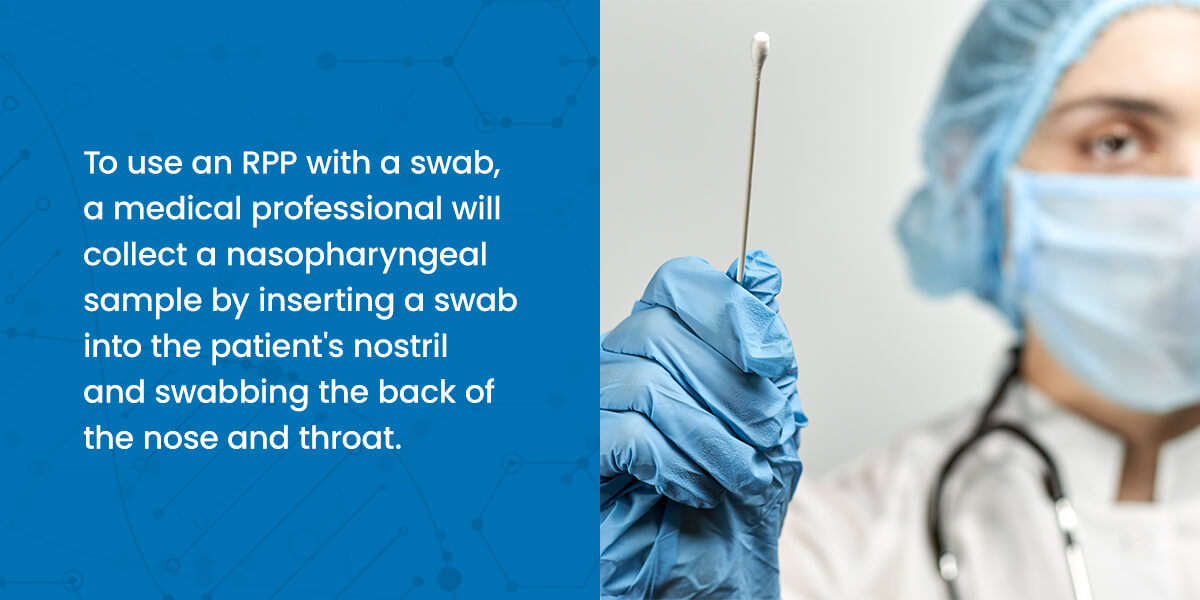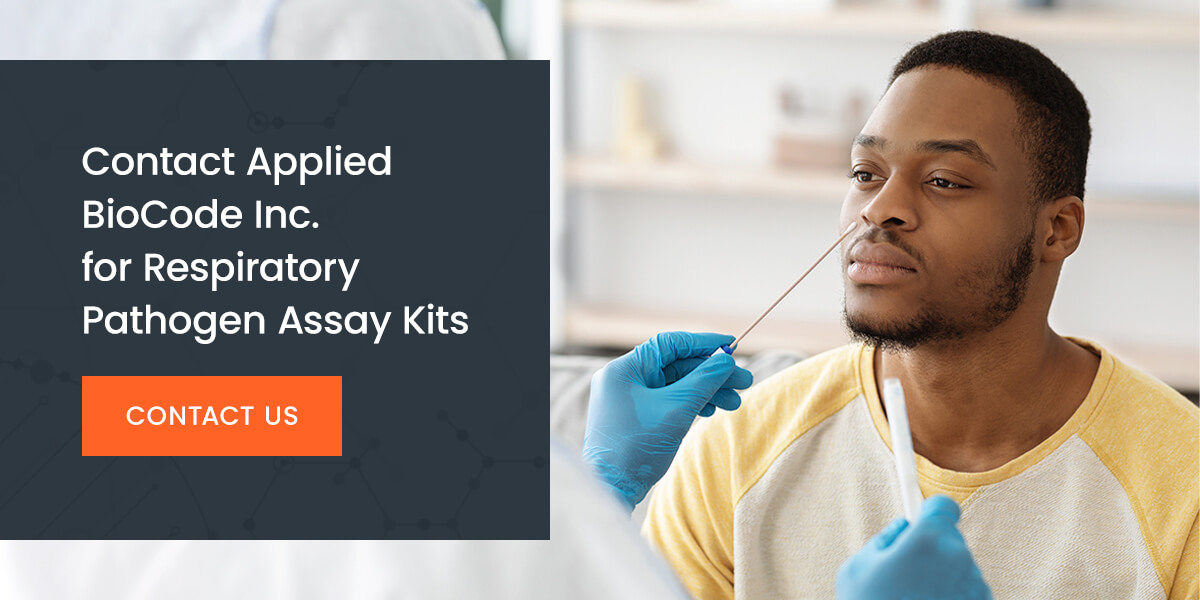Table of Contents
- What Does a Respiratory Pathogen Panel (RPP) Test For?
- How Is a Respiratory Pathogen Panel Test Used?
- What Do the Test Results Mean?
A respiratory pathogen panel (RPP) checks for nucleic acids from viruses and bacteria present in the respiratory tract by extracting these pathogens from nasopharyngeal swabs (NPS). Unlike other respiratory tests such as cultures, a respiratory pathogen panel only needs one sample to detect numerous types of pathogens and yield results. Because of this, it can determine if more than one type of pathogen is causing an infection.
Alongside their physical effects, upper respiratory infections generate a significant economic strain, with individuals missing over 20 million school days and 20 million work days. Lower respiratory infections also present a high risk of complications, with bacterial pneumonia potentially causing sepsis if the bacteria spread from the infection site. Additionally, bronchitis can lead to respiratory failure in severe cases.
These issues are just a few reasons why it’s vital to test for respiratory infections, especially when there’s a possibility of complications, to reduce poor health outcomes and economic strain.
What Does a Respiratory Pathogen Panel (RPP) Test For?
RPP tests can detect several kinds of pathogens. Respiratory pathogen assay kits can test for microbes such as:
- Coronavirus: Coronaviruses HKU1, OC43, 229E, and NL63 can cause mild to moderate upper respiratory infections and lower respiratory illnesses such as bronchitis or pneumonia.
- Influenza A and influenza B: These two subtypes are the major cause of yearly flu cases in humans, with cases heightening in the colder months. From 2010 to 2020, the flu caused an estimated 9 to 41 million illnesses annually, as determined by the Centers for Disease Control and Prevention.
- Parainfluenza 1, 2, 3, and 4: Parainfluenza viruses spread through coughs and sneezes like influenza does but can also pass to others through physical contact. They can cause both upper and lower respiratory tract infections.
- Human metapneumovirus A/B: These two subtypes cause mild to moderate upper and lower respiratory infections that can turn into pneumonia or bronchitis in people with weak immune systems or children and older adults. Metapneumovirus generally becomes prevalent alongside RSV and influenza cases and reaches its height in winter and spring.
- Respiratory syncytial virus (RSV) A/B: RSV can prove particularly serious for infants and small children, with up to 80,000 children younger than 5 years old hospitalized yearly. It generally causes mild symptoms but can progress in severity in older adults and young kids.
- Adenovirus: Along with respiratory infections such as croup, the common cold, and pneumonia, adenoviruses can cause illnesses like conjunctivitis and gastroenteritis. Types 3, 4, 7, and 14 are most commonly known for facilitating respiratory conditions.
- Human rhinovirus/enterovirus: Many cases of the common cold are facilitated by the human rhinovirus (HRV). Non-polio enteroviruses can also cause this illness. HRV is responsible for most upper respiratory infections that individuals experience throughout spring, summer, and fall, while certain strains of enterovirus have the highest infection rates in summer and fall.
- Chlamydia pneumonia: Like many other pathogens listed here, C. pneumonia causes upper and lower respiratory infections. This bacteria type is spread year-round without a particular peak season, with older adults, military service members, and children being most at risk.
- Bordetella pertussis: Responsible for whooping cough, B. pertussis bacteria present the highest risk to infants. The disease has a seven-day incubation period and can cause vomiting, fever, runny nose, and weeks-long coughing fits.
- Mycoplasma pneumonia: This bacteria type causes conditions like atypical pneumonia and tracheobronchitis, with these illnesses reaching their peak in summer and fall. M. pneumonia‘s incubation period can range from one to four weeks.

How Is a Respiratory Pathogen Panel Test Used?
Respiratory pathogen assay kits are used for patients who exhibit symptoms or signs of a respiratory tract infection, such as coughing, a runny nose, sore throat, or fever.
Not every patient who presents symptoms or signs may receive an RPP, as this test is often used with patients who are seriously ill or may suffer complications from a respiratory infection. This test can help diagnose what type of respiratory infection is present and enable physicians to decide on a proper treatment plan based on the pathogen(s) found.
To collect samples, a medical professional will collect a nasopharyngeal sample by inserting a swab into the patient’s nostril and swabbing the back of the nose and throat. After rotating the swab, they remove it for testing. Professionals who test using nasal aspirate inject a sterile saline solution into the patient’s nose using a syringe and then apply careful suction to retrieve the sample.
What Do the Test Results Mean?
An RPP can yield positive or negative results. A positive result means a certain pathogen or more than one pathogen was detected and is likely causing the respiratory infection. Positive results for more than one pathogen generally signal a co-infection.
Note that individuals can test negative for all the pathogens the panel identifies and still have signs or symptoms of a respiratory infection. This phenomenon might occur because of several factors, including the following:
- The condition is not caused by bacteria or a virus.
- The pathogen causing the condition is not available in the panel.
- The infection-causing pathogen is below the panel’s detection levels.
- Concurrent antimicrobial therapy is affecting the test results.
- The patient has a lower respiratory tract infection that is not detected by NPS.
False positives may be yielded due to cross-contamination by target pathogens or cross-reactivity with other organisms in the respiratory tract. It is also possible for dead microbes in the respiratory tract to give a false positive, as the panel does not differentiate between living and dead pathogens.

Contact Applied BioCode Inc. for Respiratory Pathogen Panel
When you need to conduct respiratory pathogen panels for patients, choose solutions from Applied BioCode Inc. for flexibility and high throughput.
The Applied BioCode® Respiratory Pathogen Panel is a qualitative multiplexed nucleic acid-based in vitro diagnostic test. It simultaneously identifies and detects nucleic acids from all pathogens listed previously and can offer results in five hours. You can process up to 188 samples within an eight-hour shift for the efficiency your operation needs when facing peak seasons for certain respiratory conditions.
Additionally, the Data Masking option allows for the masking and unmasking of pathogen targets as ordered by the clinician. This panel test is intended for use with the BioCode® MDx-3000 instrument and can be used alone or in parallel with two other Applied BioCode® panels.
Get in touch with us today for pricing and any other information you may need on this testing option.


